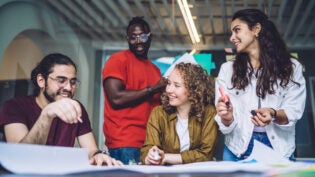
The year 2022 is a specific moment in time in more ways than one. The platitude “business as usual” has got a whole new meaning, too.
Well, it’s not like changes don’t happen all the time, but developments have become too swift of late. What with remote work taking big strides and people looking for flexible contracts and working hours, there truly is much and more to be done to improve your business.
Let’s see how leadership is evolving in 2022 and what leaders can do to boost their business operations.
-
Building a Supportive Company Culture
There’s one good outcome of the latest pandemic: it has shown that empathy is crucial. Business leaders simply have to be empathetic and committed in a way that will allow the employees to reflect on their sense of purpose in a positive way.
The first thing that must be done is — setting up a positive company culture. One that builds a “foundation of trust and a mutually supportive culture,” as Lesley Cooper, management consultant and CEO of WorkingWell puts it.
The efforts undertaken so far are discouraging, mildly put. A Gallup poll undertaken recently shows that only 19% of Americans think that management communicates efficiently, which has become glaringly obvious since the onset of the latest pandemic (prior to the pandemic, only 13% of employees thought this way).
This brings us to the next point: efficient communication.
-
Encouraging Efficient Communication
It’s no rocket science that communication is crucial for success in every aspect of business (and life, for that matter). With the rise of new technologies, both the term “communication,” and the means to achieve efficient communication have changed dramatically. Effective workplace communication can be done through an instant messaging app, during meetings, or even through email.
Did you know that e-communication and social media, in particular, have already changed the brain patterns and cognitive abilities of the generations born into the digital era?
As a result, people’s attention span has decreased considerably and the whole scope of doing business has changed to reflect this “new reality.”
Teachers have been warning for years that a revision in education is late in coming seeing as students can’t stay concentrated long enough to follow traditional lessons anymore; as a result, businesses are already applying different communication and learning methods to reflect the trend (for lack of a better term). Also, don’t forget to consider the communication with your customers as well – with the help of answering service companies, this communication can be very pleasant and efficient as well.
-
Establishing Appropriate Learning Methods
In addition to using new tech for more efficient communication, it is advisable to apply the same approach to learning.
It’s well-known that employees are looking for continual learning, but the term has also changed. Classrooms have become obsolete; online learning (and especially online learning that embraces entertainment elements such as gamification) has become the norm.
Thankfully, there are many different options to combine so that every business can adapt their learning plans with employees’ desires, but it’s still hard work with lots of experimenting.
-
Adapting to Changes
By definition, leaders constantly strive to adapt to changes — that’s why they’re called leaders to begin with. However, leaders of different generations may see things differently, specifically because they’ve grown up in radically different circumstances.
This basically means that “adapting to change” may mean one thing to a, say, 40-something leader and quite another to a 30-something leader.
This is just the starting point, though. Other changes are also taking place, at a stellar pace to boot. Just consider remote work, automation, and new tech (AI in particular) and all the necessary adjustments these drastic changes bring forth.
-
Changing Obsolete Definitions
By now, it should be crystal clear that many established business practices simply can’t hold the fort anymore.
Terms like “hybrid and “agile” are all the rage these days, and if your business isn’t following suit, it won’t remain competitive for long.
Cooper says that “Employees have shown how adaptable and elastic they can be in meeting the challenging demands of work and life,” adding that, “Business leaders need to recognize that there is little ‘slack’ left in the system, and you cannot ‘trade’ on the goodwill of staff inevitably.”
This adds another factor to the mix: the life-work balance.
-
Embracing Hybrid Work Models
For employees and freelancers to be able to achieve the desired work-life balance, a flexible working schedule is the prerequisite. This is a result of the changing work models.
It’s not just about shifts anymore; remote work must also be taken into account. When it comes to remote work, there’s another layer: different contract types.
Nowadays, people may opt to work remotely from anywhere. There are more and more digital nomads, too. This means that businesses need to offer remote work, flexible working schedules, and different contract types.
Not necessarily everyone wants to work remotely. In fact, many people are reluctant to change their established routines. That’s why businesses should consider suitable hybrid work models and pick one that will benefit the business and the employees alike.
The options are:
- Partially remote work, with flexible office space – no permanent offices; rented flex space used for periodic collaboration (but not connectivity)
- Almost entirely on premises – limited remote work, large office space the majority of managers and workers
- Partially remote work, multiple hubs – multiple offices with the workforce dispersed among them
- Partially remote work, large office space – the majority of managers and workers spend most, but not all, of their time at the office
- Almost entirely off premises – mostly remote work with no office space
- Multiple microhubs – management and employees are dispersed across small microhubs located in different cities (or countries, depending on the scope of your business operations)
Last But Not Least
With all these changes and new approaches, leadership has changed a good deal and is certain to keep changing in the future. It would seem that the rapid shift in trends is stepping up its pace, waiting for no man.
It is, therefore, necessary to establish a solid foundation that allows for necessary adaptations. There’s nothing wrong with learning on the go, but company values must be upheld.
Don’t hesitate to change obsolete business processes even when it means experimenting in the beginning. Set up an efficient anonymous feedback system. Offer the latest tech. Keep all employees in the loop. Be more empathetic. Be more flexible. Adjust your hybrid work models.
There’s so much yet to do!
4316 Views












